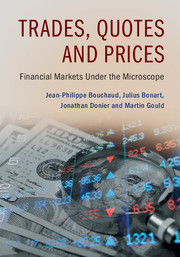Book contents
- Frontmatter
- Dedication
- Contents
- Preface
- Acknowledgements
- PART I HOW AND WHY DO PRICES MOVE?
- PART II LIMIT ORDER BOOKS: INTRODUCTION
- PART III LIMIT ORDER BOOKS: MODELS
- PART IV CLUSTERING AND CORRELATIONS
- PART V PRICE IMPACT
- PART VI MARKET DYNAMICS AT THE MICRO-SCALE
- PART VII ADVERSE SELECTION AND LIQUIDITY PROVISION
- PART VIII MARKET DYNAMICS AT THE MESO-SCALE
- PART IX PRACTICAL CONSEQUENCES
- Appendix
- Index
PART IX - PRACTICAL CONSEQUENCES
Published online by Cambridge University Press: 26 February 2018
- Frontmatter
- Dedication
- Contents
- Preface
- Acknowledgements
- PART I HOW AND WHY DO PRICES MOVE?
- PART II LIMIT ORDER BOOKS: INTRODUCTION
- PART III LIMIT ORDER BOOKS: MODELS
- PART IV CLUSTERING AND CORRELATIONS
- PART V PRICE IMPACT
- PART VI MARKET DYNAMICS AT THE MICRO-SCALE
- PART VII ADVERSE SELECTION AND LIQUIDITY PROVISION
- PART VIII MARKET DYNAMICS AT THE MESO-SCALE
- PART IX PRACTICAL CONSEQUENCES
- Appendix
- Index
Summary
Introduction
We are now approaching the end of a long empirical, theoretical and conceptual journey. In this last part, we will take the important step of accumulating all this knowledge about markets to illuminate some important decisions about how to best act in them. In the following chapters, we will address two practical topics of utmost importance for market participants and regulators: optimal trade execution and market fairness and stability.
For both academics and practitioners, the question of how to trade and execute optimally is central to the study of financial markets. Given an investment decision with a given direction, volume and time horizon, how should a market participant execute it in practice? Addressing this question is extremely difficult, and requires a detailed understanding of market dynamics that ranges from the microscopic scale of order flow in the LOB (e.g. for optimising the positioning of orders within a queue or for choosing between a limit order and a market order) to the mesoscopic scale of slow liquidity (e.g. for scheduling the execution of large investment decisions over several hours, days or months). Many important questions on these topics have been active areas of research in the last two decades.
The final chapter of this book will address the critical question of market fairness and stability. These topics have been at the core of many debates in recent years – especially with the rise of competition between exchanges and high-frequency trading. In this last chapter, we will discuss how some market instabilities can arise from the interplay between liquidity takers and liquidity providers, and can even be created by the very mechanisms upon which markets are built.
In this jungle, regulators bear the important responsibility of designing the rules that define the ecology in financial markets. As we will discuss, because the resulting system is so complex, sometimes these rules can have unintended consequences on both the way that individual traders behave and the resulting price-formation process. Therefore, sometimes the most obvious solutions are not necessarily the best ones!
We conclude with a discussion of an interesting hypothesis: that markets intrinsically contain – and have always contained – some element of instability. From long-range correlations to price impact, this book has evidenced a collection of phenomena that are likely inherent to financial markets, and that we argue market observers, actors and regulators need to understand and accept.
- Type
- Chapter
- Information
- Trades, Quotes and PricesFinancial Markets Under the Microscope, pp. 381 - 383Publisher: Cambridge University PressPrint publication year: 2018



